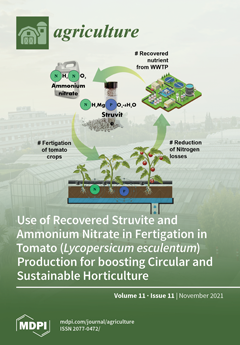Soil amendments, such as composts and biochar, are currently widely used as substrates in container gardening. Although different types of wastes have been used in composting, formulating growing mediums for specific plants using different materials is necessary. In the present study, organic substrates
[...] Read more.
Soil amendments, such as composts and biochar, are currently widely used as substrates in container gardening. Although different types of wastes have been used in composting, formulating growing mediums for specific plants using different materials is necessary. In the present study, organic substrates comprising mixtures of (a) broiler chicken wastes composted with sugar bagasse, sawdust, urban tree, napier grass, or cotton residues, and (b) five different proportions of biochar (0%, 15%, 30%, 45%, and 60%) were used to produce mineral and flavonoid-rich parsley plants. The sawdust-based substrate led to the highest yields (27.86 g pot
−1 on average), regardless of the amount of biochar added; however, this substrate resulted in plants with no appreciable antioxidant activities. Plants grown using the tree-based substrate had moderate yields (16.95 g pot
−1), and the highest phenolic levels (e.g., 7.93 mg GAE g
−1) and antioxidant activities (DPPH scavenging activity over 11.17 g TE g
−1). Such activities were better described by the presence of apigenin-7-apiosylglucoside and diosmetin-apiosylglucoside. Moderate yields were also obtained with the cotton-based substrate; however, such yields were only obtained at biochar proportions greater than 30%; this substrate led to the highest K contents (47.19 g kg
−1). The lowest yields (3.20 g pot
−1) and N (20.96 g kg
−1), P (1.33 g kg
−1), K (33.26 g kg
−1), and flavonoid (13.63 mg CE g
−1) contents were obtained with the napier-based substrate. However, this substrate led to the production of parsley plants with the highest levels of anthocyanins (0.40 mg CGE g
−1), which may have accumulated as stress sensors and defense components. The bagasse-based substrate also led to high yields and appreciable flavonoid contents with 60% biochar. In most cases, no linear relationship was found between the biochar amount and the chemical parameters evaluated. Overall, the substrates formulated using urban tree residues had higher suitability for parsley development than those formulated using sugar bagasse, sawdust, napier grass, or cotton residues.
Full article





